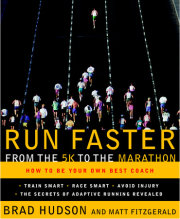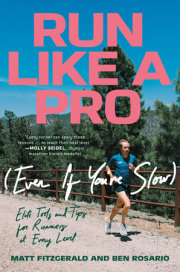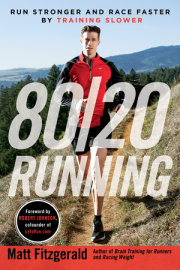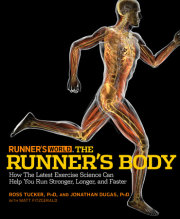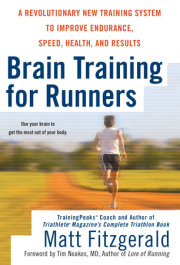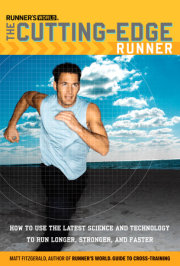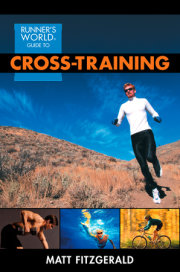Chapter 1
Adaptive Running
Every elite running coach has a training philosophy. Mine is called
adaptive running. It is based on my belief that a responsive, evolving, creative approach to training is better than an approach that is too structured and formulaic. Simply put, there is no single training formula that works perfectly for every runner. Nor is it possible to predict exactly how a runner will respond to any particular training formula. What’s more, even when a certain formula works well for a runner, he or she changes as a result of using it, so the formula must also change to produce further improvement. For these reasons, a rigid, one-size-fits-all training program will never allow you to realize your full potential as a runner. It may get you started, but it will only take you so far. Adaptive running becomes the natural way to train when you recognize that training must be customized to you individually and adapted every day based on your response to recent training.
My experience in coaching and advising a pair of elite runners—who also happen to be a married couple—provides a good illustration of why an adaptive approach to running is necessary. A few years ago, Shayne Culpepper, a 5,000-meter specialist, asked me to help her qualify for the 2004 Olympics. Shayne fared so well off the program I created for her (which you can read about in chapter 4) that her husband, Alan Culpepper, also an elite runner, decided to copy parts of it. The problem was that Alan was a completely different type of runner from Shayne. Alan has muscles that contain a lot of slow-twitch fibers; he’s designed for endurance more than speed. Shayne, on the other hand, has a lot more fast-twitch fibers. Speed comes naturally to her. The training program I gave Shayne was specifically designed for a 5,000-meter runner with a lot of speed. It was not designed for a marathoner who’s all slow--twitch, like Alan. Consequently, when he borrowed some of Shayne’s training, Alan did not get the dramatic fitness and performance boost Shayne had gotten. Instead, he quickly became fatigued and his fitness stagnated. He tried to ignore these warning signs and push through, but the situation only worsened. Eventually, he went back to his old system, having set back his seasonal development by many weeks.
The moral of this story is twofold. First, it points to the fact that no two runners are the same. If you give two runners the same training program, they will get very different results, even if they are runners of similar ability. Alan’s initial mistake was to assume that what worked for Shayne would work for him. Second, my experience with Shayne and Alan Culpepper demonstrates that runners must train responsively, modifying their training based on how recent training has affected their bodies. Alan’s biggest mistake was to persist in training Shayne’s way even though it clearly wasn’t working for him. Alan is actually one of the smartest self-coached runners I know, so you can be sure that if he’s making these kinds of mistakes, most competitive runners are.
There are plenty of coaches and runners who understand that no two runners are the same, and that runners must adjust their training based on how they are currently feeling and performing. Yet very few coaches and runners view these realities as major considerations in the planning and execution of a training program. The typical running coach customizes the training plans he prescribes in terms of volume (miles per week), but that’s about the extent of it. The rest is formulaic. Likewise, the typical competitive runner modifies her training when an injury occurs or in cases of significant fatigue, but fails to modify her training in response to subtler “surprises” (e.g., feeling unexpectedly flat on the day of a planned key workout) in the way her body responds to planned training.
The difference between my training philosophy—adaptive running—and the more typical approach to training is that I view these two lessons (first, that no two runners are the same, and second, that every runner must train responsively) of Alan Culpepper’s experience as central to the planning and execution of training. I believe that there are many more factors besides the amount of running mileage a particular runner can handle that must be taken into account when creating an individually customized training plan. I also believe that planned training should be adjusted not only when major setbacks occur, but almost daily, based on a complete assessment of the runner’s immediate training needs. In other words, I believe that every workout should be planned in pencil, not ink.
Imagine a spectrum that ranges from one-size-fits-all training plans at one end and made-from-scratch plans for each runner at the other end. The typical approach to training is closer to the one-size-fits-all end of the spectrum. Adaptive running is closer to the made-from-scratch end of the spectrum. Of course, there isn’t a coach or runner in his right mind who believes that there is truly a single training plan that can work for every runner. Nor do I believe it makes any sense to reinvent the wheel of training for each runner. But there is a big difference between the amount of customization that the typical coach does in planning a runner’s training and the amount of customization I do for my runners and recommend for self-coached runners like you.
Now imagine another spectrum that ranges from strict adherence to planned training at one end to total spontaneity at the other end. The typical competitive runner trains in fairly strict adherence to the plan, and with fairly little spontaneity. If the training plan calls for 12 quarter-mile repeats in 80 seconds apiece on Thursday, then by God, he’s going to run 12 quarter-mile repeats in 80 seconds apiece on Thursday, even if he feels awful from the very first step of the workout. My approach to training encourages far more spontaneity—not arbitrary changes to the plan, but informed changes based on how the runner has responded to recent training. Naturally, there isn’t a runner on earth who is completely unwilling to deviate from planned workouts. I don’t advocate a make-it-up-as-you-go approach, but I do put far more emphasis on reaction and less emphasis on planning than the typical competitive runner does.
Every competitive runner trains with the objective of achieving peak-race goals. Conventional training and adaptive running are both oriented toward this objective. The difference, in my view, is that adaptive running is a more reliable way to get from point A to point B, because it entails planning the route that’s best for each individual’s starting place and is open to taking all kinds of helpful “detours” around unexpected obstacles along the way. In the following pages, I will give you a general overview of my adaptive running system. Subsequent chapters will provide detailed information on how to practice adaptive running in the way that works best for you.
Adaptive running is based on two rules and four principles. The purpose of the “Two Rules of Running” explained in the next section is to simplify the conceptual side of training as much as possible. These two rules are not specific to adaptive running but are truly universal: Every training system must adhere to them to be effective. In my experience, most runners fail to practice both rules as well as they should. I certainly broke them many times in my competitive days. The four principles of adaptive running discussed in the final section of this chapter represent my understanding of the best way to practice the two fundamental rules of running.
Perhaps all of this talk of rules and principles strikes you as being a bit too theoretical and not terribly practical. But the fact of the matter is that it’s very important for you to get a solid mental grasp of adaptive running before you begin trying to practice it. This is because practicing adaptive running effectively requires that you take charge of your development as a runner in a way that you probably haven’t before. It will oblige you to make independent decisions and solve unique problems. Simply put, it will require you—and enable you—to become your own coach. I promise you that having a solid grasp of the universal rules of running and the principles of adaptive running will help you in these situations even more than the detailed guidelines on how to practice adaptive running that you’ll find in subsequent chapters.
The Two Rules of Running
Effective training can be boiled down to two simple rules. If you fully understand these rules, then adaptive running begins to make a lot of sense. And if you obey them, you will be successful as a runner. Rule one is this: Understand how the human body adapts to different types of training, and train accordingly—that is, do what works and avoid doing what -doesn’t work. Rule two is as follows: Learn how your
individual body adapts to various types of training, and train accordingly—that is, do what works for
you, and avoid doing what -doesn’t work for you, even if this means that you do things differently than most other runners do. Let’s take a closer look at each of these rules.
Rule #1: Understand how the human body adapts to different types of training, and train accordingly.
As I suggested above, training must be customized to the individual runner, but it -doesn’t need to be reinvented for every runner. Despite our many genetic and situational differences, we’re all human, and our similarities really outweigh our differences. So we respond similarly to various types of training stimuli. Every runner builds greater endurance by doing longer runs. Every runner develops greater aerobic capacity by doing high-intensity intervals. No runner can run to exhaustion every day without becoming injured or overtrained. And so forth.
The sports of modern distance running, cross-country running, and track and field are a little more than a century old. Over the past eleven or twelve decades, runners and coaches have tried all kinds of training methods, with varying degrees of success. Methods that seemed to yield good results were repeated and imitated. Those that did not were usually abandoned. Contemporary training methods represent a collection of “best practices” that have survived the test of time. The general methods used by expert coaches and experienced competitive runners are proven to work well for every runner, as long as they are appropriately adapted to the individual. Making an effort to learn, understand, and base your training on our sport’s “best practices” will give you the most solid possible foundation for success. It would take you more than a hundred years to find them on your own by trial and error. Having said this much, I must add that it’s also important to analyze conventional training methods with a skeptical eye, because there are some common practices that don’t make a heck of a lot of sense under close scrutiny. For example, even in this enlightened age it is still common for marathon runners to use short intervals such as 400-meter repeats to “sharpen up” for a marathon in the final weeks of training. If you think about it, that’s a bit like a 400-meter track specialist using 20-mile runs to “sharpen up” for a championship 400-meter race. Key sharpening workouts are most effective when they closely simulate the speed and endurance demands of your race. Thus, a
fast 20-mile run is a better marathon sharpening workout than a set of short intervals at 3,000-meter race pace on the track. This may sound commonsensical, but many distance runners train as though the thought has never crossed their minds.
A lot of runners and coaches also make the mistake of assuming we know all we need to know about how the human body responds to training, so there’s no point in trying to innovate. But I believe that effective training innovations are still possible. I spend as much time as any running coach on earth picking the brains of other top coaches and runners, studying all of the latest relevant exercise physiology literature, and making various other efforts to uncover new methods worth trying. This never-ending quest for fresh practical knowledge has led me to incorporate several unusual features into my adaptive running system that have proven beneficial for my athletes and would also be beneficial to most other runners. These methods include the use of very short, very steep, very fast hill sprints to build strength and power, and incorporating race--pace training throughout the training cycle, from the beginning of the introductory period straight through to the end of the sharpening period.
Adaptive running is the product of my exposure to a wide variety of training methods as a runner and as a student of the sport, my skeptical appraisal of even the most widely practiced methods, and my experimentation with unusual practices that seemed worth a try and proved useful. While customization, responsiveness, and evolution are major elements of adaptive running, my system also incorporates a number of standard practices that I consider the best of the best, based on my cumulative experience. Even though I train each of my runners uniquely on the level of details, on a general level there are certain characteristics that each runner’s training shares with the others. These general characteristics represent the training methods that I have found to be beneficial for every runner, and therefore to be essential characteristics of any successful training program. There are 12 such general characteristics of my training method, which I will discuss in detail in chapter 2. I want you to learn and apply them all in your training, at least to start with, but you must adapt them to your individual needs, and you must not hesitate to move away from one or more of them in certain ways as you develop and learn more about what really works best for you.
Let me be clear: It’s impossible to draw a clear line that marks where the universal human responses to training practices end and individual responses begin. There is plenty of disagreement even among the most experienced coaches and runners concerning which training methods truly represent the best practices that every runner should apply. Yet quite a lot is known about how the human body responds to different types of training. Learning about these cause-and-effect relationships is an indispensable shortcut to better running. Again, you will learn my take on these relationships, in the form of the 12 characteristics of adaptive running, in chapter 2.
Copyright © 2008 by Brad Hudson. All rights reserved. No part of this excerpt may be reproduced or reprinted without permission in writing from the publisher.


